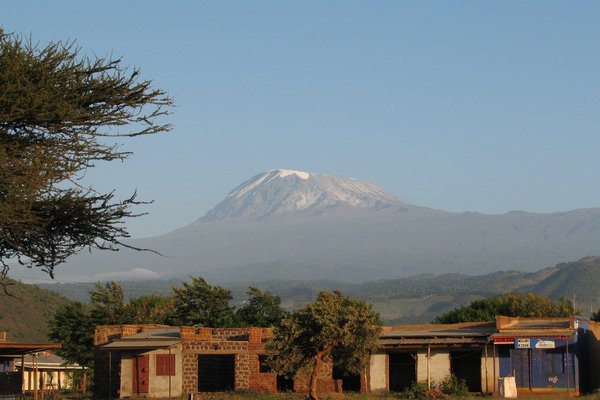Tanzania
Kilimanjaro National Park
Kilimanjaro National Park protects the highest mountain in Africa (5,895m), which is also one of the largest volcanoes in the world.
Mount Kilimanjaro stands out for its snow-capped peak and glaciers. Five vegetation zones cover its various altitudes: montane forest, moorland, upland moor, alpine bogs and alpine desert. The park is rich in mammal species.
Community Perspective: Climbing Kilimanjaro is “possible for anyone who is reasonably fit and does a bit of mental and physical preparation” – and 5 of the reviewers so far did so. However, it is possible to visit the park on a day hike too – see the reviews of Squiffy and Els.
Site Info
Official Information
- Full Name
- Kilimanjaro National Park (ID: 403)
- Country
- Tanzania
- Status
-
Inscribed 1987
Site history
History of Kilimanjaro National Park
- 1987: Inscribed
- Inscribed
- Type
- Natural
- Criteria
- vii
Links
- UNESCO
- whc.unesco.org
- Official
-
- storymaps.arcgis.com — Tanzania Parks: Kilimanjaro
- Related
-
- tanzania-web.com — Link
All Links
UNESCO.org
- whc.unesco.org — whc.unesco.org/
Official Website
- storymaps.arcgis.com — Tanzania Parks: Kilimanjaro
Related Resources
- tanzania-web.com — Link
News Article
- Sept. 12, 2023 aa.com.tr — Fire erupts on Mount Kilimanjaro
- Aug. 18, 2022 theguardian.com — Kilimanjaro gets high-speed internet so climbers can tweet or Instagram ascent
- Feb. 15, 2021 outsideonline.com — Tanzania Approves a Cable Car on Kilimanjaro
- Oct. 12, 2020 uk.reuters.com — Firefighters try to contain fire on Mount Kilimanjaro
- Aug. 2, 2019 voanews.com — Tanzania Plans to Install Cable Cars on Mount Kilimanjaro
Community Information
- Community Category
- Natural landscape: Mountain
Travel Information
High entrance fees
Recent Connections
-
Perfect Inscriptions
1987 -
Sir Wilfred Thesiger
Climbed it in Feb 1962 (aged 51). Descr… -
Megaherbs
giant groundselsSee en.wikipedia.org
Connections of Kilimanjaro National Park
- Individual People
-
-
Sir Wilfred Thesiger
Climbed it in Feb 1962 (aged 51). Described here -
Ernest Hemingway
In 1933 Hemingway and Pauline went on safari to East Africa. The 10-week trip provided material for Green Hills of Africa, as well as the short stories "The Snows of Kilimanjaro" and "The Short Happy Life of Francis Macomber". (Wiki)
-
- Geography
-
-
Volcanic plugs
Lava Tower on top of the mountain -
Territorial Highest points
Mt Kibo 5895m/19340ft -
World's most prominent mountains
Mt Kilimanjaro 4th most prominent (5882m/10m/Mt Everest) -
World's Highest Topographically isolated summits
4th most isolated (5509/5895) -
On National Border
On Kenya border -
Glaciers
"The glaciers now measure about 0.8 square mile (2 square kilometers), down from 4.6 square miles (12 square kilometers) in 1912." There is considerable debate about whether/how long they will last. -
Highest (over 5000m)
Kilimanjaro (5895m)
-
- Trivia
-
-
Tourist Treks
Climb of Kilimanjaro -
Built or owned by British
Kibo hut built 1932 by the British 'Mountain Club of East Africa' -
Depicted on National Coat of Arms
Tanzania -
In Video Games
Civilization VI; Civilization VII -
Greatest Altitude Variations
1830m - 5895m (Mt Kibo): 4065m difference -
On beer cans and bottles
Kilimanjaro* -
Fatal Accidents or 'disasters'
"we estimate the number of people who die on Kili each year to be about six or seven. It should be noted that the study does not include the death of porters, for whom a post-mortem is not compulsory and thus the number of fatalities they suffer is more difficult to quantify with any degree of accuracy."
-
- Ecology
-
-
Strepsirrhini
northern greater galago, brown greater galago, Uluguru bushbaby -
Elephants
African elephant -
Stratovolcanoes
-
Ratites
common ostrich -
Endemic Species that include the WHS name
Kilimanjaro Tree Frog (Strongylopus kilimanjaro), Kilimanjaro Giant Lobelia, Kilimanjaro Mouse Shrew -
Megaherbs
giant groundselsSee en.wikipedia.org
-
- Damaged
-
-
Wildfires
October 2020See whc.unesco.org
-
- World Heritage Process
-
-
Inscribed on a single criterion only
vii. to contain superlative natural phenomena or areas of exceptional natural beauty and aesthetic importance -
Perfect Inscriptions
1987
-
- Religion and Belief
-
-
Sacred Mountains
"sacred to the Chaga people who believe god Ruwa resides on the top" (wiki)See en.wikipedia.org
-
Axis Mundi
See en.wikipedia.org
-
- WHS on Other Lists
-
-
Biodiversity hotspot
Eastern Afromontane -
WWF Global 200
Terrestrial, Montane Grasslands and Shrublands: (104) East African Moorlands -
IUGS Geological Heritage Sites
The Pleistocene Kilimanjaro Volcano -
Globally Important Agricultural Heritage Systems (GIAHS)
Shimbwe Juu Kihamba Agro-forestry Heritage SiteSee www.fao.org
-
- Timeline
-
-
Pliocene
the important thing about Kilimanjaro is the late emergence within the Rift Valley setting – this was largely within the last 3 million years.
-
- Visiting conditions
-
-
High entrance fees
70 US dollar (daily charge, 2017) -
Foreigner prices
35 versus 70 USD conservation fee. Residents and East African citizens get the local fee as well.
-
- WHS Names
-
-
Named after a Mountain
Mt Kilimanjaro 5895m
-
- Literature & Film
-
-
Location for a classic movie
The Snows of Kilimanjaro (1952)See en.wikipedia.org
-
In The Simpsons
“Simpson Safari” (2001) -
Works by Nobel Prize winning authors
Hemingway (1954) - Snows of Kilimanjaro
-
News
- aa.com.tr 09/12/2023
- Fire erupts on Mount Kilimanjaro
- theguardian.com 08/18/2022
- Kilimanjaro gets high-speed intern…
- outsideonline.com 02/15/2021
- Tanzania Approves a Cable Car on K…
Recent Visitors
Visitors of Kilimanjaro National Park
- Afshin Iranpour
- Alberto Rodriguez Gutierrez
- Alex Baranda
- alicemears
- Ali Zingstra
- Ammon Watkins
- amychemu
- Andrea Szabo
- Artur Anuszewski
- Ask Gudmundsen
- Aspasia
- Atila Ege
- Brett Baumann
- brornt
- Carlo Sarion
- chapnis
- Christoph
- Csaba Nováczky
- czesioszpachelka
- Dagmara
- David Marton
- Dirk-pieter
- Dolemite92
- DouglasR
- Elf21
- Els Slots
- fedemarch92
- Fernweh
- Iain Jackson
- IreneKD
- Janos
- Jarrod_Byham
- Jasonfd247
- Javier Coro
- jballard650
- Jeanne OGrady
- Joel on the Road
- jonathanfr
- Jon Opol
- Kbecq
- KeithBailey
- Knut
- Little Lauren Travels
- Lucio
- Ludvan
- Luis Filipe Gaspar
- Lukemarshall
- Marinemajor
- Marlies van Wolfswinkel
- maryhattie
- Matthewrw
- M.HATADA
- Michael Ayers
- Morodhi
- Mstrebl1990
- Mtlmr
- Niall Sclater
- Nihal Ege
- PabloNorte
- Paul Schofield
- Peltzi
- Pieter Dijkshoorn
- Pink Bunny
- Piotr Wasil
- Potsdamer
- Priyaranjan Mohapatra
- Randi Thomsen
- Roman Bruehwiler
- Shandos Cleaver
- Solivagant
- Squiffy
- Squire Sullen
- Stefan Loov
- Svein Elias
- Thomas Buechler
- Tim Allen
- triathlete_16
- Truls Brekke
- Vanessa Buechler
- voyager
- Waxwing
- WILLIAM RICH
- Wojciech Fedoruk
- zfish
- Zoë Sheng
Community Reviews
Show full reviews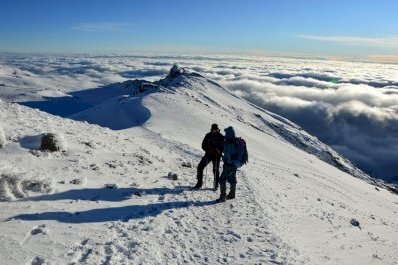
Kilimanjaro is a fascinating mountain/volcano and also a highly interesting nature park.
I climbed this mountain in 7 days with two good friends. The first day we spotted monkeys in the beautiful rain forest. We climbed up in the next rainy days. The 5th day before the summit finally the clouds were gone and we saw the majestic summit covered in snow.
In the night we departed from the highest camp (4600mtr.) and we climbed in the snow until the sun started to rise. Amazing views of sunset and the summit (5895mtr).
A long way down to the last camp at 3100 mtr. The final half day was a pleasant walk to the exit of this beautiful national park.
We combined this climb with a safari trough serengeti and ngorongoro national park. Spectacular trip!!
Keep reading 0 comments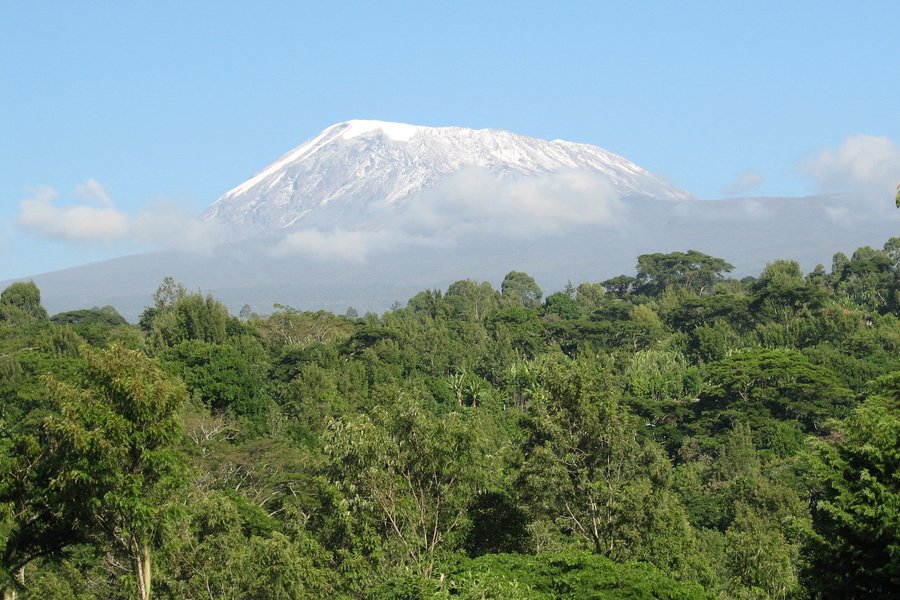
Kilimanjaro National Park is centered around Mount Kilimanjaro, the highest peak in Tanzania and in Africa at 19,341 ft / 5895 m. A dormant volcano (and the world's largest free-standing volcano), Kilimanjaro towers over an otherwise relatively flat area. The mountain is big enough to create its own weather patterns. When the mountain isn't covered in clouds, you get a stunning view of it from the nearest town, Moshi; though I've heard you can spend days in Moshi without ever seeing it.
I climbed Mt. Kilimanjaro via the Lemosho Route (8 day / 7 nights) in September 2020 on a private guided trip with a major outfitter. (Since it was during the pandemic, group tours were not an option, though I would have done one otherwise.) I also note that traveling during the pandemic likely led to a special, almost spiritual experience. There were only about ten people attempting to summit the day I did, and I had the summit to myself; in high season otherwise there could easily be 400 people summiting and crowds everywhere. The "climb" is more of a trek--there is no technical mountaineering, only a bit of rock scrambling in several places. Climbing it was a very special experience and I'd highly recommend it to anyone who is in decent physical shape!
Date of Visit: September 2020
Rating: Five stars. A giant dormant volcano with five different ecosystems on its slopes, plus the opportunity for active outdoor adventure. What else could a …
Keep reading 0 comments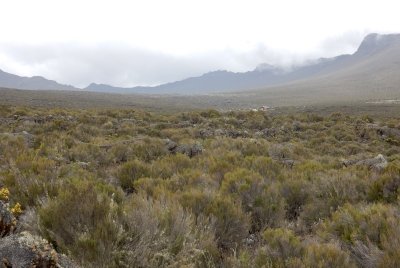
The white-necked raven eyed us beadily. It was not an attractive bird. Its feathers were scruffy and its heavy beak was all too obviously designed for scavenging on carcasses. All the same, I was glad to see it. We were in northern Tanzania, one of the most famous wildlife destinations in the world. But that raven, I realised, was the first sign of life we had seen in hours.
Firstly, hats off to those reviewers below who have summited Mount Kilimanjaro. It’s a great undertaking and I hope to follow in your footsteps one day. We debated whether trying to fit in the full ascent on our trip to Tanzania. We could have done – but it would have involved sacrificing other aspects of our itinerary. And, as our travel agent pointed out to us, “This is supposed to be a honeymoon, not an endurance test!” (The endurance test comes once the honeymoon is over I guess…)
So, like Els, we settled for a day hike on Kilimanjaro. From what I can gather, many of the trail heads are located outside Kilimanjaro National Park itself. The World Heritage Site occupies exactly the same dimensions as the National Park and both start ‘at the tree line’. So if you are still trolling through forest, you are not yet in the National Park / World Heritage Site (I think). And that’s a shame, because it’s the forests that hold much of the wildlife. All of the overnight huts are located …
Keep reading 0 comments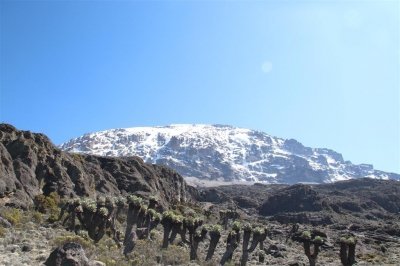
We climbed Mount Kilimanjaro end of September using the Machame route (six days, five days up and one day down).
The first day – starting at the Machame gate (1.600m) to Machame camp (almost 3.000m) – is a 10km walk through tropical forest where some monkeys can be spotted.
Day two is short with only 5km but also steep since it ends at Shira camp at 3.800m. Right from the start the forest changes to heathland/moorland.
Day three is again a 10km walk where you climb to 4.600m but descend again to Barranco camp at 4.000m. Plant and animal life disappears further in this alpine desert.
The fourth day (9km) takes you from Barranco camp to Barafu camp at 4.600m and also crosses alpine desert.
And then finally summit night! We got up around midnight to start the 6km climb to the arctic ice fields at Uhuru peak at 5.895m, which we reached after 9 hours of climbing. However, what goes up must come down so the same day we descended back to Barafu camp. In principle, it is not allowed to stay at Barafu camp after summiting but taking into account the physical state of one of our group members an exception was made.
However, this also meant that on day six we had to go all the way down from Barafu camp to Mweka gate at 1.600m, or a 23km walk.
Plenty of detailed information about the different routes is available …
Keep reading 0 comments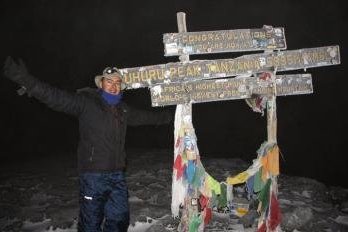
My wife and I climbed Kilimanjaro in March 2011. We used a local company named Zara Tours, who I would fully recommend (it's not permitted to climb Kilimanjaro without guides).
Although you have a choice of routes, to maximise our chances of summiting we picked the longest route: Machame. This meant basically five days up, and 1.5 days back down, staying in tents the entire way. This gives you the longest amount of time to acclimatise to the altitude, as hypoxia is more likely to stop you reaching the summit than your legs are.
Along the way, you pass through rainforest, alpine forest, moorlands, and eventually the last couple of days it's just a rocky moonscape. Not much wildlife to speak of other than birds and insects.
Our porters and guides were great, and we felt in safe hands at all times. The only disappointment was that we arrived on the summit before sunrise, and the heavy clouds rolled in early that day so we couldn't see a thing!
As another reviewer said, if you want to just "see" Kilimanjaro from the base, your best bet is to stay a night or two in the nearby town of Moshi. The summit is usually shrouded in cloud during the day, but is typically clear around sunrise and sunset.
Good luck!
You can see more of my UNESCO World Heritage Journey on Youtube, via the link below.
Keep reading 0 comments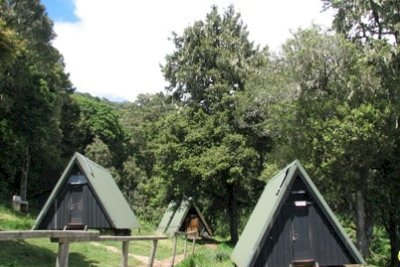
Kilimanjaro is mostly known for being the highest mountain in Africa, and for being one of the most accessible high ones to climb. My visit however was a day trip only. I did a hike to the Mandara hut, the first "station" of the climb. I went with a group of 4, accompanied by 2 local Chagga guides (aged 53 and 64). These men (brothers) had been up and down the mountain all their lives, so they were knowledgeable guides and good companions.
The entrance gate to the National Park is located near the outskirts of Marangu town. There we first had to register and pay (60 US dollars, only by VISA credit card).
The trail up to the Mandara hut is 8.2 km long and goes up to 2700m. It entirely leads through a thick forest. The path is well marked and looks relatively flat. But in reality, you're climbing during the whole stretch.
This thick forest with many high trees also means that you are well hidden from the sun. Monkeys are seen occasionally along this path, but all we did hear were birds and the cracking noises the trees make. The guides pointed out some of the flowers - colourful little things amidst the dark green, light green, olive and hundreds of other kinds of green of the trees and their leaves.
We met quite a number of climbers on their way down. Our guides never failed to ask them "Did you make …
Keep reading 0 comments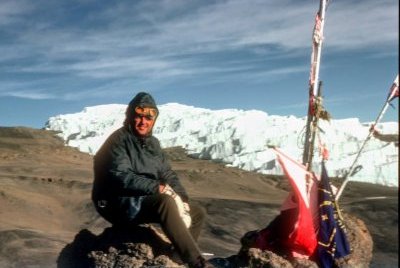
If you have just viewed this WHS from “ground level” in Amboseli Park or from Arusha why not try climbing it? It is possible for anyone who is reasonably fit and does a bit of mental and physical preparation.
I did it back in 1974 but no doubt it will be much busier, more commercialised and costly now. In those days there was only 1 route – from Marangu. But now there are many to choose from. I can’t therefore comment on which is better. The Marangu is the “classic”, and has huts (whereas the others require camping) but uses the same route up and down whereas others provide some variety! I turned up at the Marangu hotel and made up a group with 4 other tourists there. The hotel arranged the porters etc. I see from the web site that the hotel is still there offering the same services (though the English colonial ladies who ran it on those days have no doubt passed on unfortunately). It is certainly pleasantly located for a stay before and after and possibly more so than a hotel in Arusha or Moshi. We went up without hut bookings but I doubt that that is possible nowadays. Even then the middle hut (Horombo) got over-full as it alone is used on the upward and downward route.
Each day passes through different country – forest, savannah and high mountain desert. The Giant Lobelia and other unique botanical species are a highlight of the …
Keep reading 0 comments
